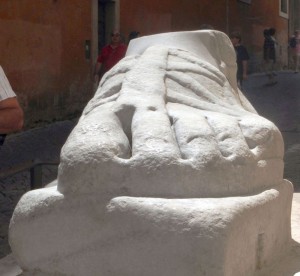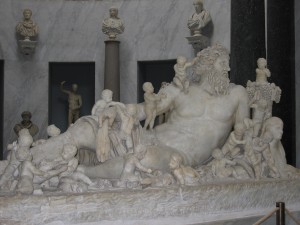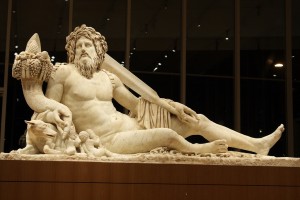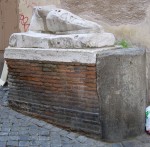 There is a small street in the Campo Marzio neighborhood of Rome’s historic center called Via del Pie’ di Marmo, or Marble Foot Way. It is named after a large marble foot perched on the side of the street that is all that remains of a colossal statue. This one foot is four feet long, so the statue it used to be a part of would have been something like 26 feet high.
There is a small street in the Campo Marzio neighborhood of Rome’s historic center called Via del Pie’ di Marmo, or Marble Foot Way. It is named after a large marble foot perched on the side of the street that is all that remains of a colossal statue. This one foot is four feet long, so the statue it used to be a part of would have been something like 26 feet high.
Clad in a Greek style of sandal called a Crepida, the foot is thought to have belonged to a colossal statue of the Egyptian goddess Isis whose cult had spread all over the Greco-Roman world after Alexander’s conquest of Egypt. A temple complex dedicated to the imported Egyptian deities Iris and Serapis (the Hellenized version of Osiris) was built in the Campus Martius area in 43 B.C. by order of the second Second Triumvirate, the ruling alliance of Octavian, Marcus Aemilius Lepidus and Mark Antony from 43 to 33 B.C. Augustus would later condemn oriental cults and advocate a return to traditional Roman religion, but worship just went underground until Caligula returned it to prominence.
The Iseum was lavishly decorated with monumental sculptures. At least six obelisks that are now elsewhere in Rome (Piazza Navona, Piazza della Rotonda, Piazza della Minerva and Piazza dei Cinquecento), Florence and Urbino, came from the temple complex. Allegorical statues The River Nile, now in the Vatican’s Chiaramonti Museum, and The Tiber, now in the Louvre museum, were both discovered on the temple grounds in the early 1500s.


The giant foot was found later in the century, along with yellow marble columns and sacrificial altars. It remained pretty much in the spot where it was found until 1878 when it was moved to its current side street so it wouldn’t obstruct the direct path to the Pantheon of Victor Emanuel II’s funeral cortege.
 Exposed to filth, pollution and a shoddy restoration that left the poor giant foot with a huge grey plaster gash marring its arch, the sculpture was nonetheless voted one of Rome’s “places of the heart” last year, and is a favorite both of locals and tourists. Last month, as part of an effort to restore some of Rome’s many outdoor sculptures, several of them of the famous talking variety, the Pie’ di Marmo was removed from its eponymous street, thoroughly cleaned and returned. It has a nice new gate around the pedestal and everything.
Exposed to filth, pollution and a shoddy restoration that left the poor giant foot with a huge grey plaster gash marring its arch, the sculpture was nonetheless voted one of Rome’s “places of the heart” last year, and is a favorite both of locals and tourists. Last month, as part of an effort to restore some of Rome’s many outdoor sculptures, several of them of the famous talking variety, the Pie’ di Marmo was removed from its eponymous street, thoroughly cleaned and returned. It has a nice new gate around the pedestal and everything.